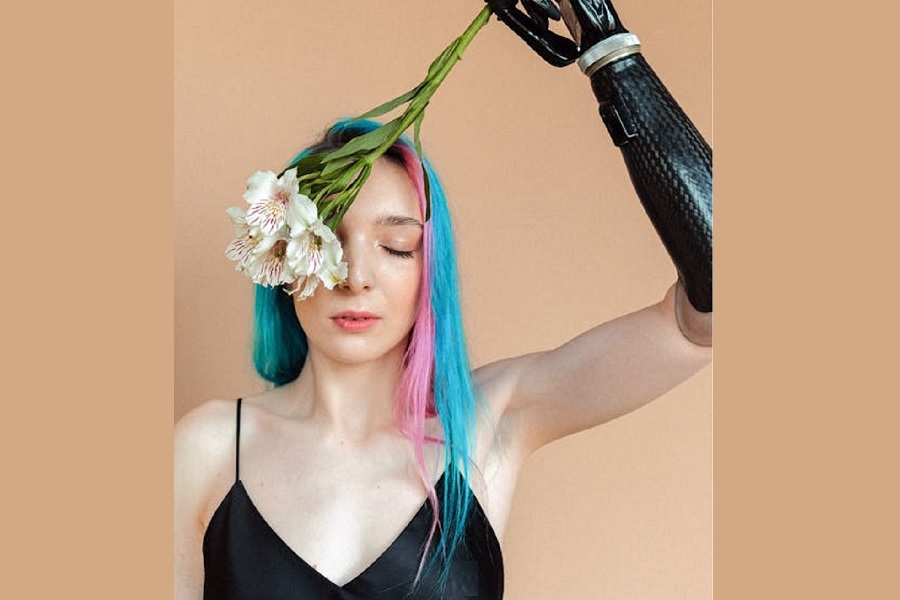
Follow us Now on Telegram ! Get daily 10 - 12 Interesting Updates. Join our Telegram Channel https://t.me/OhWomen
Download Telegram App before Joining the Channel
In a world where traditional beauty standards are constantly evolving, certain images transcend surface-level aesthetics to evoke deeper conversations about identity, strength, and self-acceptance. The image of a young woman with vibrant turquoise and pink hair, holding a delicate bouquet of flowers with a sleek, black prosthetic arm, is one such portrait — a powerful visual statement layered with symbolism and modern meaning.
At first glance, the photo captivates with its composition. The soft peach background creates a warm, inviting atmosphere. The subject’s closed eyes and serene expression reflect inner peace and confidence. Her bright, unconventional hair color — half electric blue, half bubblegum pink — suggests unapologetic self-expression. She wears a simple black spaghetti-strap dress, allowing the viewer's attention to focus not on what she wears, but who she is.
Yet the most striking aspect of the image lies in the contrast between her gentle pose and the advanced, mechanical prosthetic arm she raises. From it, she delicately holds a bouquet of white and pink flowers — symbols of purity, grace, and fragility. This juxtaposition between the organic softness of the flowers and the carbon-fiber strength of the prosthetic is both beautiful and profound. It represents the union of two seemingly opposite worlds: strength and sensitivity, technology and humanity, the artificial and the organic.
A Narrative of Empowerment
This image is not just about aesthetics. It tells a story — one of resilience, adaptation, and redefinition. In our culture, people with disabilities have long been underrepresented or misrepresented. Prosthetics, for example, were once viewed primarily through the lens of limitation or loss. But now, with advancements in technology and a shift in societal perspectives, prosthetics are increasingly seen as symbols of strength, capability, and even artistry.
For many, a prosthetic limb is not merely a medical device but an extension of identity. In this image, the woman doesn’t hide or minimize her prosthetic arm — she highlights it. She integrates it into an expression of beauty and power. This act alone is revolutionary. It challenges the idea that the body must conform to traditional ideals to be seen as beautiful. Instead, it embraces the truth that all bodies — in all their diversity — are worthy of representation, admiration, and celebration.
Beauty Reimagined
The cultural definition of beauty is expanding, and this image plays a part in that shift. The woman’s colorful hair, minimalist clothing, and prosthetic limb all break from conventional norms, yet the result is undeniably graceful. Her confidence, not conformity, defines her attractiveness. By presenting herself authentically, she invites viewers to rethink what it means to be beautiful.
This reimagining of beauty is especially important in the age of social media, where curated perfection often dominates. Real-life representations like this one remind us that beauty includes scars, stories, and survival. It’s not about erasing differences but honoring them.
Feminine Strength Redefined
The use of flowers in this image carries deep symbolism. Flowers have long been associated with femininity — soft, delicate, fleeting. But here, they are held by a mechanical limb, creating a new visual metaphor: femininity not as weakness, but as a form of powerful resilience. This redefinition of feminine strength speaks to a broader cultural moment in which women — and especially women with disabilities — are taking control of their narratives.
By combining elements of softness and steel, the image suggests that strength does not mean the absence of vulnerability, and vulnerability does not preclude strength. The modern woman is multifaceted: strong, gentle, bold, and beautifully imperfect.
Toward a More Inclusive Future
Ultimately, this photograph is more than an artistic composition — it's a visual manifesto. It calls for inclusion, visibility, and dignity for all bodies. It asks us to look beyond the surface, to question the narrow definitions we’ve inherited, and to embrace the full spectrum of human experience.
In celebrating the uniqueness of the subject — her individuality, her use of technology, her aesthetic expression — the image invites us all to reflect on our own journeys. What makes us different may also be what makes us beautiful, powerful, and whole.
Source : Oh Women